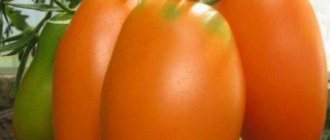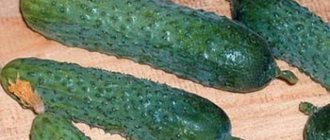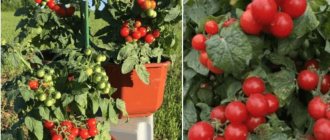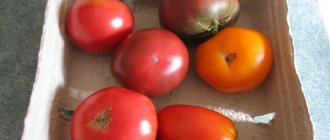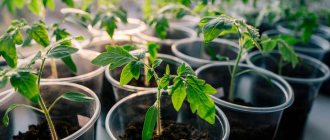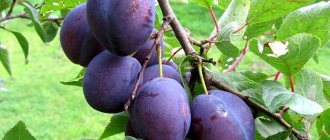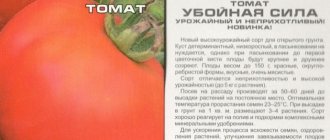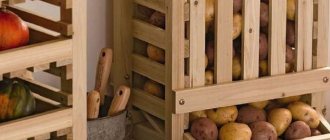Description of the variety
The Red Ball plum belongs to the so-called Chinese or Ussuri plums. The first attempts to adapt the plum tree to climate conditions with harsh winters were made back in the 19th century by the American breeder Luther Burbank. The hybrids he bred are still very popular in Europe and America, although they are not frost-resistant.
One of the hybrids, bearing the name of its creator (Burbank), was crossed by breeders from the Nikitsky Botanical Garden and the Moscow VTI of Horticulture and Fruit Growing (Kh. K. Enikeev and S. V. Satarova) with the Ussuri red plum variety. The result was included in the State Register in 1989 under the name Red Ball with the note “recommended for the Central region.”
The first mentions of plum cultivation are found in ancient Egyptian chronicles dating back to the 4th-6th centuries BC. The Egyptians did not even have to “domesticate” this culture. The plum tree is the result of spontaneous selection, obtained by cross-pollination of cherry plum and blackthorn. Therefore, there are simply no wild plums in nature.
Red ball plum is still rare in garden plots
Red Ball plum is a low (up to 2.5–3 m), but spreading tree with a rather sparse, rounded crown. The longest branches hang down. The trunk is light brown, smooth. The root system grows in width, not depth. The roots reach a maximum depth of 45–50 cm, but occupy an area approximately corresponding to the projection of the crown onto the ground. However, an adult (over 10 years old) tree still forms several roots that go 5–7 m deep.
In spring, the plum tree looks quite unusual, because first the flowers appear, and only then, when they have already fallen off, the foliage. True, you won’t be able to use this decorative effect in the garden. The Chinese plum blossoms very quickly. The flowers are white or pinkish, with five petals. Most often, 2, 3 or even 4 flowers appear from one flower bud; the tree is literally strewn with them. But not every flower will produce a fruit.
There are no leaves on the Red Ball plum tree in spring, only flowers - it looks simply amazing
The leaves are matte green, elongated, with small teeth along the entire edge. The central vein is much thicker than the others. Because of this, the sheet turns out slightly concave. But its tip is at the same time bent outward. The leaves seem to be collected in bouquets.
The creators position Red Ball as a self-fertile variety. This means that the tree pollinates itself and does not need other crops to produce fruit. But practicing gardeners note that to better guarantee a harvest, one or more pollinating varieties are still required. At the same time, the ordinary home plum is not a pollinator of the Red Ball. Choose other varieties of Chinese plum or hybrid cherry plum (Russian plum).
The fruits ripen in mid-August, as the Red Ball blooms a couple of weeks earlier than ordinary plums. The plum of this variety fully lives up to its name. The fruits are almost round, bright red, with a slightly noticeable grayish-gray or purple tint. Because of this waxy coating, they appear pink in the sun.
The skin is dense, smooth, the side “seam” is practically invisible. The pulp is sour-sweet, loose, but very juicy, light yellow in color, noticeably fibrous, with an amazing aroma. The stone is small and separates from the pulp quite easily. The weight of one plum is 35–40 g. If the weather was suitable in summer, the fruits literally stick to the branches. But when there are too many ovaries for the tree, the plums grow small and ripen 2-3 weeks later than usual.
Plum Red Ball fully corresponds to the name
One of the most common gifts in China for friends, relatives or loved ones is a fruit basket. But they never put plums in them. The fact is that the words “plum” and “parting” in Chinese sound almost the same.
This plum needs pollinators
The Red Ball plum needs pollinators. It should be remembered that, like all Chinese plums, the Red Ball blooms slightly earlier than the domestic plum, so for pollination you need to select varieties that bloom at the same time as it.
It is best to plant several different varieties of Chinese plum nearby, but varieties of Russian plum are also acceptable.
Good pollinators would be the Skoroplodnaya plum or the cherry plum varieties Kuban Comet and Zlato Scythians.
Bad weather intervened - pollinate by hand
You can also use hand pollination.
Advantages and disadvantages of the variety
The obvious advantages of the Red Ball plum variety include the following:
- Taste qualities of fruits and their versatility. They can be eaten without processing. In addition, plums of this variety are large and beautiful, which is also important.
- Early ripeness and high yield. From one tree in a warm sunny summer you can collect 15–18 kg of plums.
- Transportability. The dense skin allows the plum to be transported over long distances without compromising its appearance and taste.
- Early fruiting age. The Red Ball will bear its first harvest 2-3 years after planting in a permanent place.
- Frost resistance. Plum winters well and survives at temperatures below -40 ºС.
- The compactness of the tree and the average density of the crown. This makes the maintenance, pruning and harvesting process easier.
- Breeding prospects. A hybrid that is suitable for the climatic conditions of most regions of Russia and has excellent taste, will be extremely in demand by amateur gardeners.
With proper care, the Red Ball bears fruit stably and abundantly
The disadvantages are:
- Flowering earlier than ordinary plums. Because of this, flowers in most regions of Russia may well crumble due to returning spring frosts, which are by no means uncommon.
- The presence of pollinators is desirable to ensure fruit set.
- Root collar maturing in spring. Because of this, the plum may become rotten. The problem can be solved by planting the tree on a previously prepared mound of soil. A height of 40–50 cm is sufficient.
- Average taste. Some people don't like the characteristic sourness. The issue is controversial to say the least. As you know, the taste and color...
Boarding procedure
The plum garden is very beautiful. It's just a pity that it doesn't last long
Site selection
Planting a plum begins with choosing a suitable place for the seedling. Plum is extremely thermophilic, and without sunlight the fruits will not ripen or develop sweetness. If you plan to plant not one tree, but a whole garden, leave a distance of 2–2.5 m between seedlings, and 3–3.5 m between rows . Each plum tree requires at least 9 m² of soil for proper nutrition.
Plum also has an extremely negative attitude towards drafts, so the place should be protected from the wind. A wall covering the tree from the north, northwest or northeast is ideal. And if the wall is stone or brick, that’s even better. Heating during the day, it will give off heat at night.
Plum grows best on light sandy loam, moist loamy or fertilized clay soils, but, in principle, it tolerates any soil except highly acidified soil. Groundwater at the planting site should not come closer to the surface than 1.5 m, otherwise the roots will quickly rot and the tree will die.
Plant the Red Ball as far as possible from beds with any nightshades. Tomatoes, eggplants, potatoes and bell peppers themselves do not suffer from the fungi and bacteria that attack plums, but they inevitably attract them.
In areas with a temperate climate, the only option is spring planting of plums. Wait 5 days after the snow has completely melted. If you live in the south of Russia, you can plant the Red Ball in September.
Purchase of planting material
Choose an annual seedling, as it takes root better. Before purchasing, pay attention to the roots - they should not be too dry. Discard specimens with damaged bark (cracked, wrinkled, inelastic), a forked trunk, and a questionable condition of the trunk. If the seller allows, cut off one of the branches. When cut, the wood should be light green or white, not beige or brown.
Preparatory work
The hole for the seedling begins to be dug 18–20 days before the intended planting. The optimal depth is 60-65 cm, width and length - 70 cm. The area previously prepared for the Red Ball must be dug up, while at the same time adding dolomite flour (700-750 g per m²) to the soil to neutralize the acidity of the soil.
The soil removed from the pit is laid out so as not to confuse fertile soil (upper 20 cm) with infertile soil. Approximately the same amount of peat, rotted manure, compost or humus is added to the fertile soil. From this soil, a low mound is poured at the bottom of the pit and a peg is stuck into it to the right or left of the center by 15–20 cm. Calculate the height of the support so that it rises 70–80 cm above the upper edge of the pit.
Step by step process
When planting plum variety Red Ball, everything is important - location, choice of seedling, preparation of the planting hole
- Immediately before planting, the plum roots are soaked in water for 5–6 hours. For additional disinfection, you can use a pale pink solution of potassium permanganate, and Epin to stimulate growth.
- A seedling is placed on the formed mound, the roots are carefully straightened and sprinkled with infertile soil mixed with superphosphate (250 g), wood ash (500 g) and potassium nitrate, potassium sulfate (50 g). Nitrogen fertilizers are not applied during planting.
- Always make sure that the root collar does not end up below the top edge of the hole. This place should rise 5–6 cm above the soil. Then the soil is trampled down or slammed down. If this is not done, air will get into the voids in the soil and dry out the roots.
- Stepping back 50–60 cm from the trunk, form a low earthen mound and water the plant generously (7–10 l). Wait until the moisture is completely absorbed and mulch the Red Ball with peat (layer 5 cm thick). The next watering is recommended no earlier than 10–12 days later.
Unlike most fruit trees, the lifespan of plums is relatively short. The garden will bear fruit steadily for only 15–25 years.
Planting a plum - video
Plum care Red ball
Caring for the Chinese plum variety Red Ball consists of weeding, loosening the soil, sanitary pruning of the crown and preparing the crop for wintering.
Watering and loosening
It is important to maintain the root circle in perfect condition. Any weeds are a “home” for all kinds of pests, fungi and bacteria. The same can be said about fallen leaves and broken branches in autumn. Loosening must be done every time before watering. But only very carefully. The roots of the Red Ball are quite close to the surface.
Plum is very sensitive to soil moisture. Do not allow the soil to dry out. But it is strongly not recommended to turn the tree trunk circle into a swamp - the roots will quickly rot and the tree will die. An adult Chinese plum needs 25–30 liters of water daily; watering is carried out in the morning and evening. Of course, if there are prolonged rains, there is no need to additionally fill the drain.
Watering is especially important in June and July. At this time, the fruits ripen and at the same time new flower buds are formed - the basis of the harvest for the next year. If there is a lack of moisture, the fruits shrink and crack.
From the beginning of August, watering is sharply reduced (to once every 5 days). Otherwise, young shoots will continue to grow and will not have time to become strong enough before winter. This is bad for the Red Ball, despite the fact that the culture is winter-hardy. Young branches are much more susceptible to the negative effects of frost. After harvesting, the tree is again watered abundantly for 15–20 days. This will help the plum accumulate the required amount of nutrients and become saturated with moisture before going into hibernation.
Preparing for winter
Despite winter hardiness and frost resistance, plums need to be prepared for winter. It is always better to be safe than to discover a dead tree later in the spring. Therefore, the plum trunk is covered with a thick layer of hay, straw, spruce branches and securely fixed, wrapped in burlap. You can form a mound about 50 cm high around the trunk from sawdust, rotted manure or humus. This will help protect the tree not only from frost, but also from rodents. A plum planted this or last year can simply be bent to the ground, tied all the branches into one “broom” and covered with snow.
Another option is to wrap the lower third of the trunk with nylon tights or a special covering material that allows air to pass through. It is undesirable to use polyethylene and roofing felt - condensation forms under them, causing heating and rot of the root collar. Additionally, a special mesh will protect the plum from rodents.
Trimming
Chinese plum needs regular sanitary pruning
The Red Ball does not need to form a plum crown. It’s not too thick anyway. Only sanitary and preventive pruning is recommended. In addition, it is imperative to remove root growth, which has no practical value, but robs the fruit of the nutrition it needs.
When starting the procedure, you should remember that the fruits of the Chinese plum are formed only on last year’s shoots.
In the spring, cut out all the branches that have frozen over the winter and shorten the old shoots by about a quarter of the length. All shoots growing downwards are also cut off. In the fall, the plum is freed from branches affected by diseases and pests, and the so-called tops are removed - branches growing vertically upward, which definitely will not bear fruit.
All tools used must be sharp and disinfected. Immediately treat the sections with a solution of copper sulfate or potassium permanganate and cover them with garden varnish.
And two more important points:
- Even if the Red Ball begins to bloom within two years after planting, 90% of the flowers must be cut off. This is necessary for the tree to take root better.
- In the future, the plum has a steady tendency to set more fruits than it can ripen. Therefore, approximately half of the green plums should be cut off, leaving only those that are guaranteed to receive enough sunlight and heat. In this way, you can achieve almost annual fruiting, rather than getting a harvest every 2-3 years.
Recommended fertilizers
The Red Ball plum is undemanding to the presence of fertilizers in the soil. Annual fertilizing is not required - it is enough to add nutrients to the soil once every 3-4 years (depending on the condition of the tree). Fertilizing is carried out comprehensively, using both mineral and organic fertilizers.
In a tree-trunk circle with a diameter of 1–2 m (based on the age of the plum), add 10 liters of humus, compost or rotted manure for each m² and dig up the soil to a depth of at least one spade bayonet. This is done very carefully so as not to damage the roots located close to the surface.
Mineral fertilizers are diluted with water and 2-3 days after adding organic matter, water the soil in the tree trunk circle. Young seedlings need 10–15 liters of solution, adult trees require 20–25 liters. For a ten-liter bucket, 50 g of simple superphosphate (or 25 g of double superphosphate) and 20 g of potassium sulfate are enough.
This way the plum is fed in the fall. If the soil is not very fertile, for every second fertilizing the recommended fertilizer rate is doubled.
In early spring, you can add ammonium nitrate (30 g per 10 liters of water). Immediately before flowering, urea and potassium sulfate (25–30 g each) are added to the soil. Fertilizers are scattered around the tree trunk, which is immediately loosened well. After 6–7 weeks, the Red Ball is fed with urea and nitrophoska (30 g each).
Secrets of plum care - video
Features of growing Skoroplodnaya plum
In general, agricultural technology for cultivating domestic and Chinese plums does not differ significantly. But some species and varietal characteristics of Skoroplodnaya will need to be taken into account in order to extend the life of the tree and increase productivity.
Landing
The requirements for fertility and soil structure do not differ from the growing conditions of domestic plum. When landing, you will need to consider the following points:
- Skoroplodnaya prefers autumn planting, as its root system is well adapted to low temperatures. The seedling takes root well during the winter and quickly grows in the spring.
- For Chinese plums, soil acidity levels should absolutely not exceed neutral. The most suitable would be slightly alkaline soil. Deoxidation is best done with dolomite flour (400 g/m2) or twice as much wood ash.
- It is better to place the tree on a natural or artificial mound 50–60 cm high. Planting on a hill will raise the roots of the tree from groundwater, the depth of which should not be higher than 1.5 m, and also less snow and melt water will accumulate in the area of the trunk, which will reduce the risk of root collar overheating.
- The tree placement scheme is 3x4 m.
- A drainage layer must be laid at the bottom of the planting hole (50 cm deep, 70 cm in diameter).
- After the soil settles, the root collar should drop exactly to ground level. To do this, when planting, it is raised by 5–7 cm, depending on the structure of the soil.
Otherwise, the process of planting Skoroplodnaya has no special features.
Nuances of care
Trees are provided with routine care, taking into account the following nuances:
- The optimal formation is sparsely layered with a clearly defined central conductor and frame branches with second- and third-order branches.
- You need to prepare strong supports in advance. The branches of the Chinese plum are not very thick, so they often break under the weight of the harvest.
- In general, Chinese plums are moisture-loving, but Skoroplodnaya has increased resistance to drought, so you should not allow it to become waterlogged, especially in the rainy season. The general rule for watering is that the soil should be wet to a depth of 40 cm; there is no point in using more water, since the root system of the Chinese plum is superficial. Usually 10 liters per square meter of crown projection is sufficient.
- When feeding, you need to take into account that “Chinese” does not tolerate chlorine, therefore any fertilizers that contain it are unacceptable for plants.
Protection from adverse factors
Carrying out standard preventive measures will minimize damage from diseases and pests or avoid them.
Diseases and pests
The variety has good immunity to major diseases. There is a small probability of infection by fruit rot, and brown spots of sporulation of the fungus appear in a circular pattern on the fruits. Affected plums fall off, they need to be collected and destroyed, and the trees should be sprayed with 1% Bordeaux mixture or fungicides.
The probability of Skoroplodnaya plum being affected by fruit rot is small, but still exists
Among the pests, aphids and codling moths can create problems for the gardener. The risk of their occurrence is quite high. Signs of infestation by these insects are as follows:
- The pollinated plum aphid densely colonizes leaves, young shoots and stalks, sucks the juice from them, weakening the plants. The leaves do not curl.
- In unripe fruits, plum moth caterpillars damage the pulp and unhardened pit; in ripe plums, they damage the pulp around the pit. Damaged plums fall off.
Trees are sprayed with insecticides. Against aphids, you can use a solution of washing soap in rain or river water (200–300 g/10 l).
Wintering trees
In order for trees to survive the winter without damage, the following work must be carried out to protect them:
- In late autumn, when night temperatures set below zero, you need to wrap the trunk with two or three layers of air-permeable protective material.
- If there is a large amount of snow, you need to free the branches from it, which, as already mentioned, are quite thin and may not withstand the weight.
- To protect the root collar from overheating, the following measures are carried out: After snow falls, immediately remove the trunk from it to allow deep freezing of the soil under the root collar.
- When winter comes to an end, the tree trunk circle is cleared of snow within a radius of 1.5 m from the trunk and grooves are dug to drain melt water.
Diseases and pests
The Red Ball plum is resistant to kleasterosporiosis and gum disease caused by sunburn. But besides those mentioned, there are other diseases - fungal and bacterial. In addition, not a single breeder is able to protect the variety he bred from insects. Therefore, it is important to be able to recognize symptoms in time, identify a pest or disease, and be able to deal with them effectively.
Common plum diseases and treatment methods - table
| Disease | Symptoms | Control and prevention measures |
| Moniliosis | Flower and vegetative buds, ovaries and fruits become brown with gray spots and soft to the touch. In rainy weather, the fungus can develop almost like an avalanche. | Immediately remove all affected buds, ovaries and fruits and burn them. At the same time, cut off an additional 7–10 cm of branches that appear healthy. Most likely, the fungal spores have spread throughout it too. 2-3 days before flowering, spray the buds with a solution of Nitrofen (check the instructions for the recommended dosage) or a 1% solution of Bordeaux mixture, copper or iron sulfate. As soon as the plum blossoms, re-treat with fungicides (Captan, Fthalan, Cuprozan and other preparations based on copper oxychloride). |
| Coccomycosis | Brown-red or purple spots appear on the outside of the leaf, quickly increasing in size; on the bottom there is a solid pastel pink coating. The leaves turn yellow, dry out, and fall off in mid-summer. The fruits stop growing and dry out before they have time to ripen. | After harvesting, clean the tree trunk, dig up the soil and treat all plums with a solution of copper oxychloride (35–40 g per 10 liters of water) or any preparation based on it. |
| Fruit rot | Soft brown spots appear on ripening fruits, quickly increasing in size. Then spores mature in each spot - white, beige or grayish tubercles located in concentric circles. | Inspect the tree regularly and remove fruits even with the slightest signs of disease. Destroy them immediately. A 1% solution of Bordeaux mixture is not a very effective remedy, but there is no more effective one. The solution is sprayed on the plum when the future fruits reach a size of 2–3 cm. |
| Rust | In mid-summer, reddish-brown bumps appear on the upper side of the leaves. They gradually grow until they occupy the entire leaf area. After 2–3 weeks, damaged leaves fall off. The tree's growth slows down and it most often freezes in winter. | Every autumn, thoroughly clean the tree trunk area of fallen leaves - there fungal spores can easily survive the winter. Before flowering, spray the tree with a 0.8% solution of copper oxychloride (80 g per 10 liters of water). The approximate norm for one plum is 3 liters. After harvesting, carry out preventive treatment with a 1% solution of Bordeaux mixture. |
| Marsupial disease | The fruits become deformed, growths and tubercles appear, and the seed seems to dissolve. Then the plums are covered with a dense whitish waxy coating. | Spray almost blooming buds and a newly flowering tree with a 1% solution of Bordeaux mixture. Collect and destroy damaged fruits regularly. |
| Root cancer | Brownish flat growths appear on the lower part of the trunk, especially on the root collar and at the roots. An adult tree practically does not increase in growth, young seedlings do not take root and dry out. The disease develops especially actively in dry weather. Another risk factor is neutral or slightly alkaline soil. | Do not plant plum trees in places where trees previously affected by a similar disease grew, no matter how much time has passed. Disinfect any garden tools for at least a quarter of an hour in a deep purple solution of potassium permanganate. The fungus penetrates through cracks and damage in the bark. Treat all sections with a 3% solution of copper sulfate and carefully cover them with garden varnish. Cut off the growths with a sharp knife and process in the same way. |
| milky shine | The leaf blades acquire an uncharacteristic silvery-white sheen, especially noticeable in the sun. Then holes appear in the leaves, they dry out and fall off. The bark darkens, as if the tree has been burnt. Seedlings damaged by severe frosts are most susceptible to the disease. | In the fall, cover the lower third of the trunk and skeletal branches with a lime solution. Before flowering, add urea to the soil (30 g per m² of tree trunk circle). |
Diseases affecting plums, pictured
The milky sheen is clearly visible as soon as the sun comes out
If root canker appears on the trunk, it is quite easy to detect, but if only the roots are affected, most likely you will not understand anything until the tree dries out
With marsupial disease, plums grow in the most bizarre shapes
Leaves covered with rust fall off, the tree practically does not grow
Coccomycosis is one of the most common problems with fruit trees; you may not expect a harvest from affected plums
With plum blight, it is important to notice the problem in time - if the weather is rainy, the fungus spreads very quickly
Plum pests and their control - table
| Pest | Symptoms | Control and prevention measures |
| Apple scale insect | Despite the name, it loves not only apple trees. The pest attaches to the bark, sucking the sap from it. The trunk and shoots seem to be dotted with dark brown tubercles-growths. Trees subjected to a massive invasion of scale insects dry out. | Before flowering, water the plum with Nitrofen (0.5 kg per 20 liters of water), evenly distributing the solution around the tree trunk. Immediately after the tree has finished blooming, water it with Karbofos (1.5 kg per 20 liters of water). |
| Plum aphid | It settles in entire colonies on the underside of leaves, sucking the juice from them. As a result, the leaves curl, dry out and fall off. The fruits do not ripen and rot. | For prevention, the tree trunk circle is cleared of root growth every autumn. If the tree suffered from aphids last summer, in the spring (early or mid-April) it is sprayed with a 10% solution of Nitrophen, and just before the flower buds open and after the plum has bloomed - with a 10% solution of Benzophosphate. |
| codling moth | The caterpillars of this butterfly eat plums from the inside, paying special attention to the pit. Small holes are visible on the surface of the fruit, sealed with something resembling dirty cotton wool. | Collect and destroy all fallen unripe plums. In early spring, disinfect the bark with a bright pink solution of potassium permanganate. 12–14 days after flowering, spray the tree with a solution of Chlorophos (2%) or Karbofos (3%). |
| Hawthorn caterpillar | The caterpillars feed mainly on leaves, but also do not disdain buds, flowers and young fruit ovaries. A massive pest infestation can leave a plum tree completely bare. | We should not forget about such a method as manual collection of caterpillars. Among the insecticides used to combat them are Aktelik, Corsair and Ambush. Treatment with a 1% solution is carried out 2 times per season - in early May and after flowering. |
| Cherry shoot moth | Caterpillars feed on buds, buds, leaves, and gnaw tunnels in young shoots. | For prevention, regularly loosen and dig up the soil in the tree trunk circle to destroy the larvae. In early April, spray and water the plum with a 3% Nitrofen solution. Just before flowering, spray with Karbofos solution (10%). |
| Cherry slimy sawfly | The larvae gnaw out the leaves, leaving only veins. | Spray the tree with a 10% solution of Trichlorometaphos-3 or Karbofos. |
| Plum moth | The butterfly lays eggs in unripe fruits. The caterpillars hatching from the eggs eat all the pulp and crawl around the garden. Transparent or whitish drops resembling gum are visible on the skin of the affected fruit. The plums turn pinkish-purple, the skin wrinkles, and the fruits fall off. | In mid-May, when the caterpillars hatch en masse, spray the plum with a 10% solution of Benzophosphate or Karbofos. After 12–14 days, repeat the treatment. The norm for one tree is 2–3 liters. Between sprayings, collect caterpillars by hand. |
| Ringed silkworm | The caterpillar feeds on leaves and unopened buds, and weaves nests from material resembling cobwebs in the forks of young shoots. | Immediately remove all nests and discovered egg clutches from the tree and destroy them. Immediately after flowering, spray the plum with Antobacterin or Dendrobacellin. Folk remedies include infusions of chamomile, wormwood or tobacco ash. |
Harmful insects in the photo
Ringed silkworm caterpillars weave nests from material similar to spider webs
The plum moth feeds on fruit pulp
There is almost nothing left of the foliage during a massive invasion of the cherry slimy sawfly.
Cherry shoot moth caterpillars will not refuse plum leaves either.
The hawthorn caterpillar is easily recognized by its characteristic longitudinal black and yellow stripes.
The codling moth feeds mainly on apple pulp, but does not disdain plums
Plum aphids settle on trees in huge colonies
Apple scale insects are clearly visible on the plum trunk
Stone fruit diseases - video
Diseases and harmful insects
Diseases and pests to which this variety is susceptible if the rules of care and cultivation are not followed:
moniliosis (also known as gray rot, which affects stone fruits) - this disease overtakes trees when they have high humidity. The disease can be eliminated using Bordeaux-type liquid (you need to use a 3% solution)
Important! The solution should be used before the buds begin to appear. Secondary treatment should be performed after flowering; rust, sooty fungus - these diseases actively affect the deciduous part of the tree
To eliminate the disease, you need to water once for three weeks with a pink solution with potassium permanganate; plum aphid - this unpleasant disease can be eliminated by spraying with Fitoferm; it should be used at intervals of two weeks; The plum sawfly is a very harmful insect that can easily destroy the entire crop. Therefore, it is very important to eliminate this pest in a timely manner.
This variety of plum has been known for a very long time; many gardeners grew it on their plots, so there was a strong opinion about it, mostly positive. Here's what experienced gardeners say:
Lera, 38 years old: when I first planted this variety and it grew for a couple of years, it froze very much and grew into a very small bush rather than a tree. But over the subsequent years the situation leveled out, the tree grew stronger, grew and began to bear fruit well. The fruits are very tasty, there are a lot of them. The only downside that can be noted is that it is a bit difficult to separate the seed, but otherwise the variety is excellent. Vyacheslav, 35 years old: this variety is good because it is very unpretentious and easy to grow. For me, it began to bear fruit in the second year in huge quantities, which was very wonderful.
I haven’t noticed any particular diseases, sometimes there are problems with flowering, so it is very important to plant pollinating varieties in time. Otherwise, the variety is very wonderful, it’s great to make jam from it
I recommend everyone to grow it in their garden.
Now you know all the key information about this type of plum. It has many advantages and not so many disadvantages, so it is extremely useful to grow it on your site. It is very unpretentious, so it is very popular among gardeners. The growing process itself is not too difficult; even novice gardeners can cope with it if they follow the above recommendations. By ensuring your plum tree grows and develops properly, you can enjoy a larger harvest every year.
Harvest and storage
The Red Ball plum must be collected on time. If you leave ripe fruits on the branches for at least a couple of extra days, they will burst and fall off en masse. Choose a warm, sunny day to harvest. If it rained the day before, postpone the procedure. It is not advisable to collect the Red Ball in the early morning or late evening, when the fruits are covered with dew.
Plums are collected in baskets or buckets lined with soft fabric. At room temperature it can be stored for no longer than 3-4 days. By placing the fruits in the refrigerator in open paper bags or cardboard boxes, the shelf life can be extended to 6–8 days. Be sure to ensure that fruits that emit ethylene are not placed near plums. They will overripe and burst very quickly. “Champions” in this sense are bananas, pears and apples. Freezing plums is strongly not recommended - you will get an almost tasteless homogeneous mass.
If you harvest the crop 5–6 days before final ripening and put it in a dry, dark and well-ventilated cellar with a temperature of +12…+15 ºС, you can store plums for 12–15 days. In this case, the fruits must be sorted regularly, removing fully ripe ones.
Plum is very good for health. It is distinguished by a high content of vitamin E. The fruits also contain vitamins A, C, K, P, PP and the entire group B. There are also trace elements. The highest concentrations of potassium, copper, iodine, zinc, and iron. Thanks to this composition, plum preserves youth, supports the immune system and helps prevent cancer. Perhaps this is why Queen Elizabeth II of England eats several plums every day, even before breakfast.
Plum Red Ball is highly regarded for its versatility. In addition to fresh consumption, use in the preparation of preparations for the winter (jams, marmalade, jellies, marmalade) and the production of homemade drinks (compotes, juices, syrups, wines, liqueurs, tinctures), it has several other uses:
- As a prophylactic agent in the treatment of viral and infectious diseases. The antioxidants and phytonutrients it contains help restore the immune system.
- In cosmetology. Plum seed oil contains the same antioxidants that help maintain youthful skin.
- In dietetics. Red ball plum fruits help remove excess cholesterol from the body. Therefore, it is recommended for use by those who suffer from vascular atherosclerosis. For those wishing to lose excess weight, this variety, like any other variety of “Chinese”, is not very suitable. The red ball has almost 2.5 times more calories than a regular plum.
Beneficial properties of plums - video
Application of fruits
As a universal variety “Red Ball” is used:
- in the treatment and prevention of various diseases, as it contains antioxidants and phytonutrients;
- in dietetics, since plums can remove harmful cholesterol;
- in cosmetology, where plum oil fatty acids are used;
- in the confectionery industry (jams, jams, jellies, marmalade, candy fillings);
- in the production of beverages (juices, compotes, syrups, tinctures, liqueurs, light wines).
The main advantage of domestic plums is that their low calorie content is not at all typical of “Chinese plums,” which are second only to grapes in terms of calorie content.
The Chinese love to give each other fruit baskets as gifts, but you will never see a plum in them, even one as elegant as the “Red Ball”. It’s just that the Chinese word for “plum” sounds similar to the word for “separation.”
Reviews from gardeners
If you see it on sale, don’t even hesitate, buy it right away! I have been growing this plum tree for four years now. It overwintered well during the harsh winter of 2005-2006, the tips didn’t even freeze. Feature: grows wider. It hasn’t bloomed yet because it was planted as an annual. It is not affected by any diseases, it is not eaten by weevils and caterpillars (I don’t know why). Pisarda grows next to her, she constantly has to be sprayed during weevil attacks, but this one doesn’t matter!
Helen Hunt
https://www.websad.ru/archdis.php?code=388137&subrub=%CB%E8%F1%F2%E2%E5%ED%ED%FB%E5+%E4%E5%F0%E5%E2%FC %FF
The Red Ball plum, although it has the Ussuri plum as its parent (what we call wild plum), was bred in the Krasnodar region; its winter hardiness is weak, only for favorable places. When I started gardening, I burned myself on it.
relh
https://khabmama.ru/forum/topic70978–120.html
I advise you to focus your attention on the Red Ball variety. The variety is self-fertile, highly winter-hardy, begins to bear fruit 2-3 years after planting, its fruits are large, beautiful and very tasty.
Mrria
https://www.lynix.biz/forum/luchshie-sorta-samoplodnykh-sliv-dlya-podmoskovya
Although for Russia the Chinese plum variety Red Ball is a virtually unknown crop, gardeners and gardeners in all regions are strongly recommended to pay attention to it, primarily because of its frost resistance and productivity. These qualities make it possible to harvest fruits in areas with very different climates - from the southern regions to the Moscow region, the Urals, Siberia and the Far East. If it's too cold where you live for a regular plum, feel free to plant a Red Ball and wait for the harvest.
- Author: Yulia Golova
27 years old, higher legal education, broad outlook and interest in a variety of topics. Rate this article:
- 5
- 4
- 3
- 2
- 1
(0 votes, average: 0 out of 5)
Share with your friends!
Advantages and disadvantages
The fact that the Chinese plum is a fruit already indicates certain benefits for humans. First, let's look at the chemical composition of this fruit:
- Most of the Chinese plum is water, about 82%. Carbohydrates contain about 17%, the rest comes from proteins and fats.
- Lychee is a sweet fruit, but its calorie content is low, only 66 kcal/100 g. If you carefully watch your figure, then the Chinese plum will not harm it.
- It contains many minerals, organic acids, vitamin C and potassium.
- Lychee contains valuable antioxidants.
